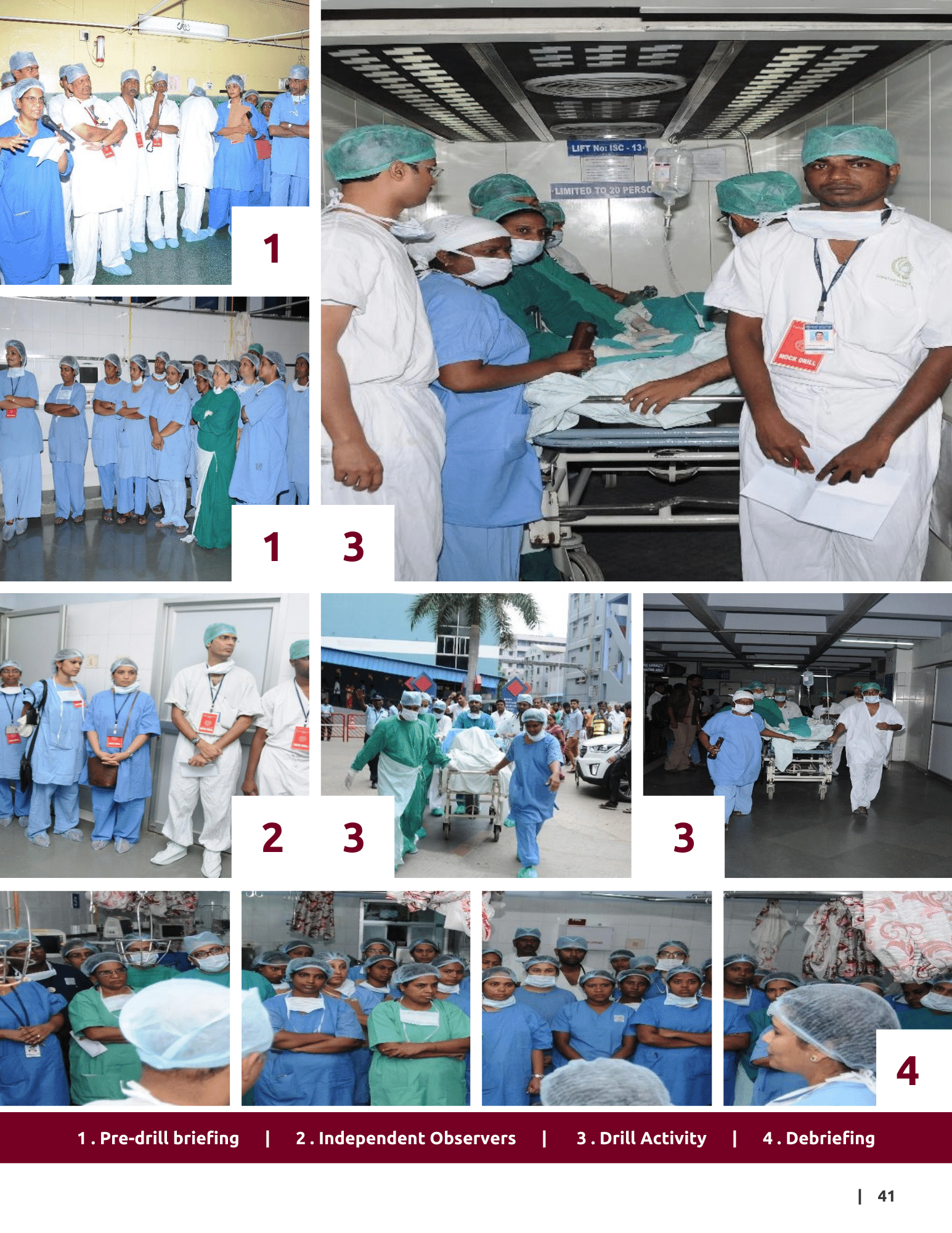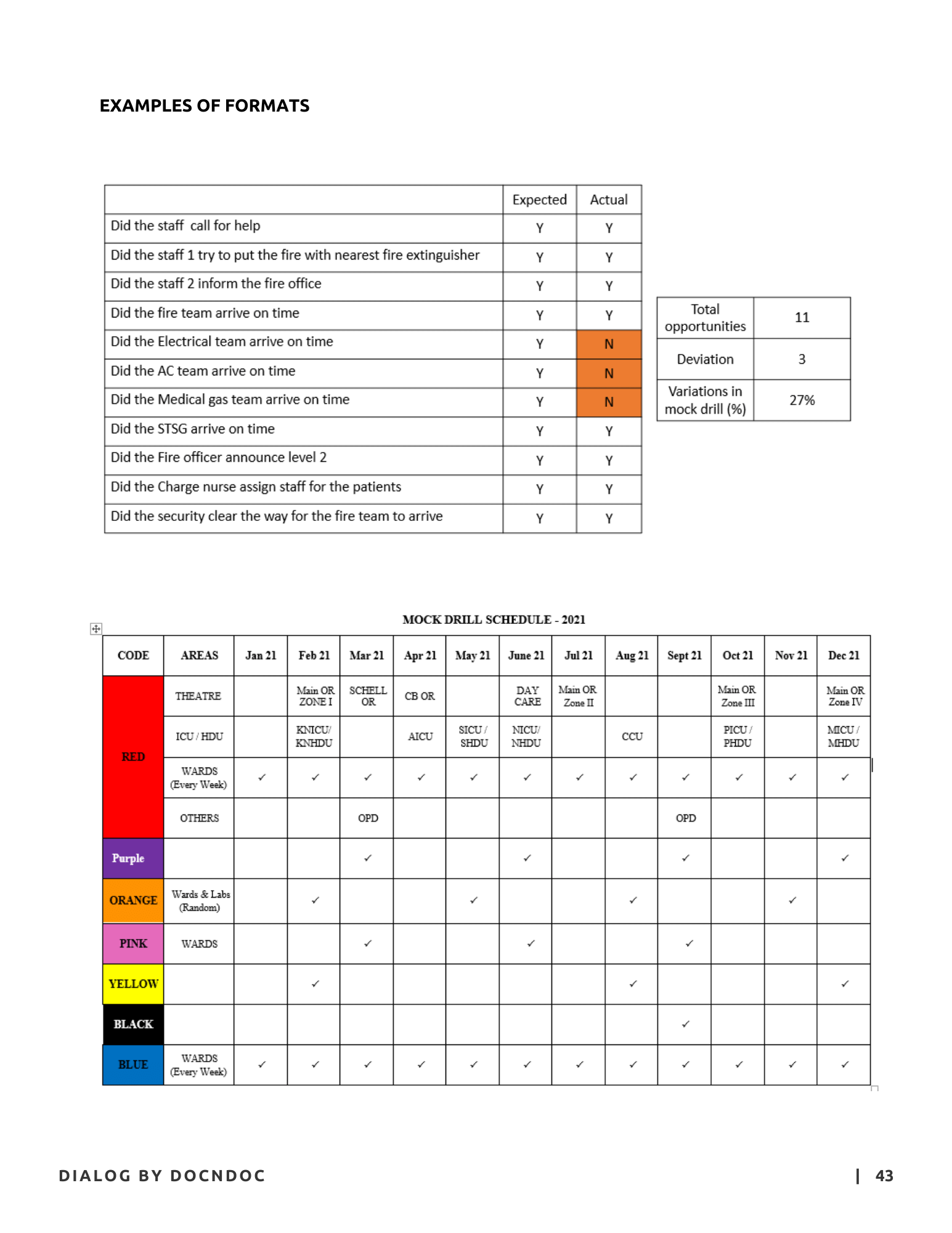
Mock drills- A hard drill makes the battle easier
READ AS MAGAZINE PDF
A mock drill is a practice to save life/ lives in a real-time situation of any kind of danger or calamity that occurs suddenly with no time or very little time to react. They are particularly important. They should be conducted to review the emergency preparedness plan of the hospital, evaluate standard operating procedures (SOP), check the understanding of the staff on their roles and responsibilities, enhance coordination among the emergency support functions and various departments, and check the workability of the systems and installations for mitigating the risk, understand gaps in the system to remove deficiencies and to execute a further improvement plan to avoid life and property loss and to enhance the ability to respond faster.
There are three categories of Drills and Exercises:
Tabletop exercise:
- Facilitated analysis of an emergency in an informal and stress-free environment.
- This is the simplest way to conduct a drill.
Functional drill:
- Simulates an emergency in the most realistic manner possible, short of moving real people and equipment to an actual site.
- Functional drills are medium-complex drills.
Full-scale drill:
- As close as possible to the real event, it takes place on location using equipment and personnel that would be called upon in a real event.
- This is a complex way to conduct a drill for the vulnerable especially.
- It may be difficult in times like these to have full-fledged drills and hospitals can adopt Table Top Exercise (TTEx) physically or even virtually. We have been fully utilizing the online platform to conduct Virtual tabletop exercises at Christian Medical College Vellore and it has proved to be very effective as it is easier to conduct and with a large number of participants connected and an excellent way to simulate the situation. It can be a hybrid- a mix of both physical drills and interviews.
Regardless of the size, complexity and risk involved in the drill, an effective drill/exercise should include the following essential elements:
- Adequately trained team personnel/equipment required/logistics support.
- A well-defined process for drill design/conduct.
- Definite criteria for evaluation.
- Qualified evaluators who are aware of the system and protocol to evaluate the participants.
Before starting the drill, a coordinating conference should be conducted with the stakeholders who will be conducting the exercise. Decisions on the objectives of the mock exercise, the scope of the exercise, selecting the type of emergency/ crisis for the mock exercise, selecting the coordinator/lead, deciding the date and venue for the tabletop/ mock exercise and the participants, and departments should be finalized.


Steps to Conduct Mock Drill
Pre-drill Briefing:
It involves scenario briefing by the coordinator to the drill team and observers where the safety precaution needed for the drill is also discussed. For an announced drill, pre-drill briefing with the participants to explain the scene and the ground rules for executing the drill.
Positioning of Independent Observers:
The independent observers should be trained and conversant with the protocol and should be deployed at key locations with a checklist/ evaluation format of the response expected which is drawn from the protocol. They should closely observe the response and document the conformances and gaps identified.
Drill Initiation:
The drill should be initiated by the lead/ coordinator in accordance with the planned drill scenario. The scenario narrative should describe the events leading up to the time the exercise begins. It should set the scene for later events and capture the attention of the participants. It could include answers to questions such as:
- How was the information relayed?
- What damages have been reported?
- What was the sequence of the events?
- Was there any advance warning issued and how long before the event?
- What factors influenced emergency procedures?
Drill Activity:
After the drill initiation, every activity and response should be carried out according to the scenario and SOPs. During the drill, independent observers should document all activities based on the criteria of the drill scenario. Each drill should have specified areas of evaluation so that all actions required are observed and evaluated.
Drill Termination:
The drill scenario should be allowed to continue till the completion of the stated objectives. The drill should be terminated by the lead/ coordinator in accordance with the plan.
Critiquing Drills:
After the drill, the lead/ coordinator should hold a session to critique the drill along with the observers and drill team. It should be two-way communication between the drill team and the participants. The process should first involve self-evaluation by the participants, then a discussion of the evaluation notes, checklists, actions taken and the overall drill performance. The critical analysis should highlight the successes, and shortcomings of the drill scenario, personnel’s actions, and equipment accessibility. The critique should include an analysis of the expected versus the actual operating actions. The incident commander should determine whether the drill objective was met or not.
Drill Evaluation Report
It is the act of observing and recording mock drill activity, by comparing the performed actions against the drill objectives. Evaluation should broadly have the:
- Details of the drill and gaps in conducting the drill with limitations.
- Observations and recommendations:
- Report the gaps identified with suggestive actions to improve preparedness.
- Feedback from the participants.
Follow-up Activity
Review the performance, where the coordinating team will decide on the closure of all the gaps with timelines. The SOP/protocol if needs to be changed should be presented to the fire safety committee and updated.
- Reviewing the performance
- Assigning responsibility to close the gaps
- Documenting closures and presenting to the committee
- Ensuring timelines for closures
Mock Drills Calendar
Drills offer the opportunity to identify training needs, establish new reflexes and teach through action, repetition and update/change the plan. Emergency drills and exercises should be conducted regularly in a hospital to test the plan and to develop the capacity of staff to respond to an emergency/ disaster/crisis. Preparing a mock drill calendar is an important activity.

Author
-

Secretary General, CAHO, Quality Manager & Associate GS, Christian Medical College, Vellore






